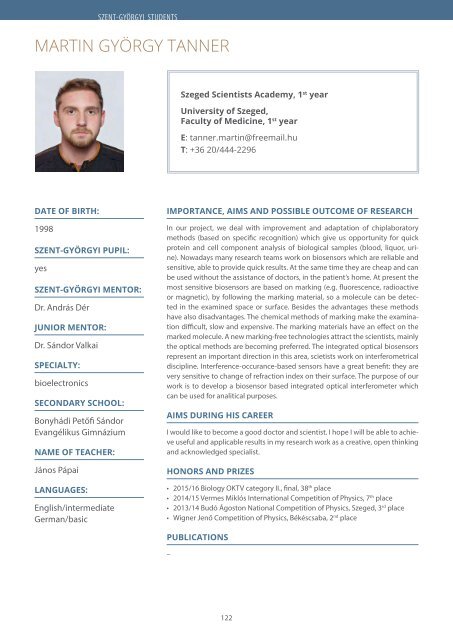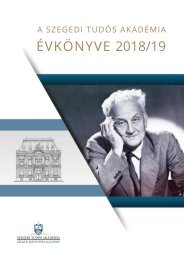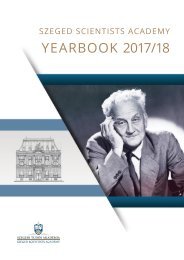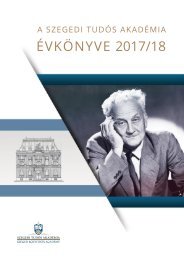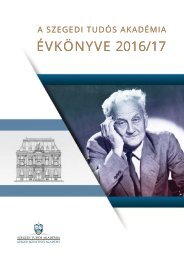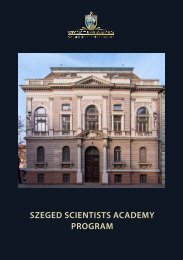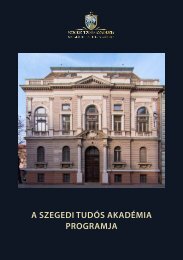SzSA YearBook 2016/17
You also want an ePaper? Increase the reach of your titles
YUMPU automatically turns print PDFs into web optimized ePapers that Google loves.
SZENT-GYÖRGYI STUDENTS<br />
MARTIN GYÖRGY TANNER<br />
Szeged Scientists Academy, 1 st year<br />
University of Szeged,<br />
Faculty of Medicine, 1 st year<br />
E: tanner.martin@freemail.hu<br />
T: +36 20/444-2296<br />
DATE OF BIRTH:<br />
1998<br />
SZENT-GYÖRGYI PUPIL:<br />
yes<br />
SZENT-GYÖRGYI MENTOR:<br />
Dr. András Dér<br />
JUNIOR MENTOR:<br />
Dr. Sándor Valkai<br />
SPECIALTY:<br />
bioelectronics<br />
SECONDARY SCHOOL:<br />
Bonyhádi Petőfi Sándor<br />
Evangélikus Gimnázium<br />
NAME OF TEACHER:<br />
János Pápai<br />
LANGUAGES:<br />
English/intermediate<br />
German/basic<br />
IMPORTANCE, AIMS AND POSSIBLE OUTCOME OF RESEARCH<br />
In our project, we deal with improvement and adaptation of chiplaboratory<br />
methods (based on specific recognition) which give us opportunity for quick<br />
protein and cell component analysis of biological samples (blood, liquor, urine).<br />
Nowadays many research teams work on biosensors which are reliable and<br />
sensitive, able to provide quick results. At the same time they are cheap and can<br />
be used without the assistance of doctors, in the patient’s home. At present the<br />
most sensitive biosensors are based on marking (e.g. fluorescence, radioactive<br />
or magnetic), by following the marking material, so a molecule can be detected<br />
in the examined space or surface. Besides the advantages these methods<br />
have also disadvantages. The chemical methods of marking make the examination<br />
difficult, slow and expensive. The marking materials have an effect on the<br />
marked molecule. A new marking-free technologies attract the scientists, mainly<br />
the optical methods are becoming preferred. The integrated optical biosensors<br />
represent an important direction in this area, scietists work on interferometrical<br />
discipline. Interference-occurance-based sensors have a great benefit: they are<br />
very sensitive to change of refraction index on their surface. The purpose of our<br />
work is to develop a biosensor based integrated optical interferometer which<br />
can be used for analitical purposes.<br />
AIMS DURING HIS CAREER<br />
I would like to become a good doctor and scientist. I hope I will be able to achieve<br />
useful and applicable results in my research work as a creative, open thinking<br />
and acknowledged specialist.<br />
HONORS AND PRIZES<br />
• 2015/16 Biology OKTV category II., final, 38 th place<br />
• 2014/15 Vermes Miklós International Competition of Physics, 7 th place<br />
• 2013/14 Budó Ágoston National Competition of Physics, Szeged, 3 rd place<br />
• Wigner Jenő Competition of Physics, Békéscsaba, 2 nd place<br />
PUBLICATIONS<br />
–<br />
122


